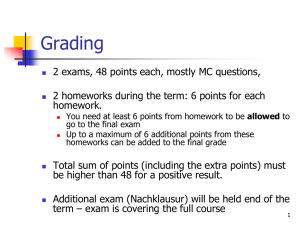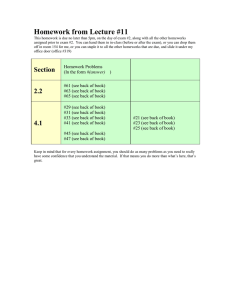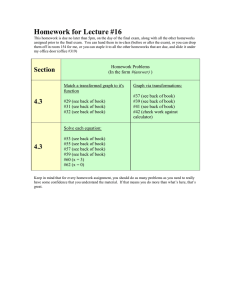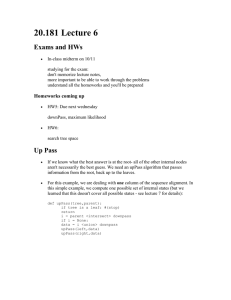Storyline-Based Homework Assignments for Power Electronics
advertisement
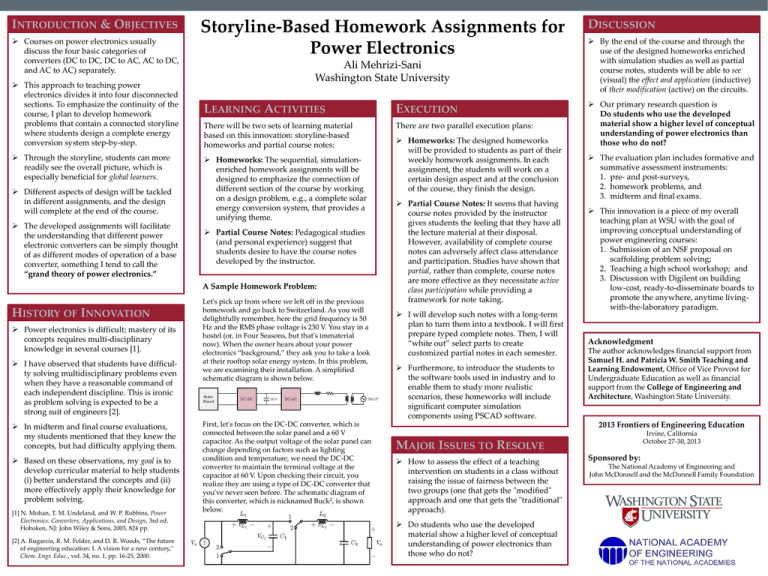
INTRODUCTION & OBJECTIVES Courses on power electronics usually discuss the four basic categories of converters (DC to DC, DC to AC, AC to DC, and AC to AC) separately. This approach to teaching power electronics divides it into four disconnected sections. To emphasize the continuity of the course, I plan to develop homework problems that contain a connected storyline where students design a complete energy conversion system step-by-step. Through the storyline, students can more readily see the overall picture, which is especially beneficial for global learners. Different aspects of design will be tackled in different assignments, and the design will complete at the end of the course. The developed assignments will facilitate the understanding that different power electronic converters can be simply thought of as different modes of operation of a base converter, something I tend to call the “grand theory of power electronics.” Storyline-Based Homework Assignments for Power Electronics Ali Mehrizi-Sani Washington State University LEARNING ACTIVITIES EXECUTION There will be two sets of learning material based on this innovation: storyline-based homeworks and partial course notes: There are two parallel execution plans: Homeworks: The sequential, simulationenriched homework assignments will be designed to emphasize the connection of different section of the course by working on a design problem, e.g., a complete solar energy conversion system, that provides a unifying theme. Partial Course Notes: Pedagogical studies (and personal experience) suggest that students desire to have the course notes developed by the instructor. A Sample Homework Problem: HISTORY OF INNOVATION Power electronics is difficult; mastery of its concepts requires multi-disciplinary knowledge in several courses [1]. I have observed that students have difficulty solving multidisciplinary problems even when they have a reasonable command of each independent discipline. This is ironic as problem solving is expected to be a strong suit of engineers [2]. In midterm and final course evaluations, my students mentioned that they knew the concepts, but had difficulty applying them. Based on these observations, my goal is to develop curricular material to help students (i) better understand the concepts and (ii) more effectively apply their knowledge for problem solving. [1] N. Mohan, T. M. Undeland, and W. P. Robbins, Power Electronics: Converters, Applications, and Design, 3rd ed. Hoboken, NJ: John Wiley & Sons, 2003, 824 pp. [2] A. Rugarcia, R. M. Felder, and D. R. Woods, “The future of engineering education: I. A vision for a new century," Chem. Engr. Educ., vol. 34, no. 1, pp. 16-25, 2000. Let's pick up from where we left off in the previous homework and go back to Switzerland. As you will delightfully remember, here the grid frequency is 50 Hz and the RMS phase voltage is 230 V. You stay in a hostel (or, in Four Seasons, but that's immaterial now). When the owner hears about your power electronics “background,” they ask you to take a look at their rooftop solar energy system. In this problem, we are examining their installation. A simplified schematic diagram is shown below. First, let's focus on the DC-DC converter, which is connected between the solar panel and a 60 V capacitor. As the output voltage of the solar panel can change depending on factors such as lighting condition and temperature, we need the DC-DC converter to maintain the terminal voltage at the capacitor at 60 V. Upon checking their circuit, you realize they are using a type of DC-DC converter that you've never seen before. The schematic diagram of this converter, which is nicknamed Buck2, is shown below. Homeworks: The designed homeworks will be provided to students as part of their weekly homework assignments. In each assignment, the students will work on a certain design aspect and at the conclusion of the course, they finish the design. Partial Course Notes: It seems that having course notes provided by the instructor gives students the feeling that they have all the lecture material at their disposal. However, availability of complete course notes can adversely affect class attendance and participation. Studies have shown that partial, rather than complete, course notes are more effective as they necessitate active class participation while providing a framework for note taking. I will develop such notes with a long-term plan to turn them into a textbook. I will first prepare typed complete notes. Then, I will “white out” select parts to create customized partial notes in each semester. Furthermore, to introduce the students to the software tools used in industry and to enable them to study more realistic scenarios, these homeworks will include significant computer simulation components using PSCAD software. DISCUSSION By the end of the course and through the use of the designed homeworks enriched with simulation studies as well as partial course notes, students will be able to see (visual) the effect and application (inductive) of their modification (active) on the circuits. Our primary research question is Do students who use the developed material show a higher level of conceptual understanding of power electronics than those who do not? The evaluation plan includes formative and summative assessment instruments: 1. pre- and post-surveys, 2. homework problems, and 3. midterm and final exams. This innovation is a piece of my overall teaching plan at WSU with the goal of improving conceptual understanding of power engineering courses: 1. Submission of an NSF proposal on scaffolding problem solving; 2. Teaching a high school workshop; and 3. Discussion with Digilent on building low-cost, ready-to-disseminate boards to promote the anywhere, anytime livingwith-the-laboratory paradigm. Acknowledgment The author acknowledges financial support from Samuel H. and Patricia W. Smith Teaching and Learning Endowment, Office of Vice Provost for Undergraduate Education as well as financial support from the College of Engineering and Architecture, Washington State University. 2013 Frontiers of Engineering Education Irvine, California October 27-30, 2013 MAJOR ISSUES TO RESOLVE How to assess the effect of a teaching intervention on students in a class without raising the issue of fairness between the two groups (one that gets the "modified" approach and one that gets the "traditional" approach). Do students who use the developed material show a higher level of conceptual understanding of power electronics than those who do not? Sponsored by: The National Academy of Engineering and John McDonnell and the McDonnell Family Foundation
